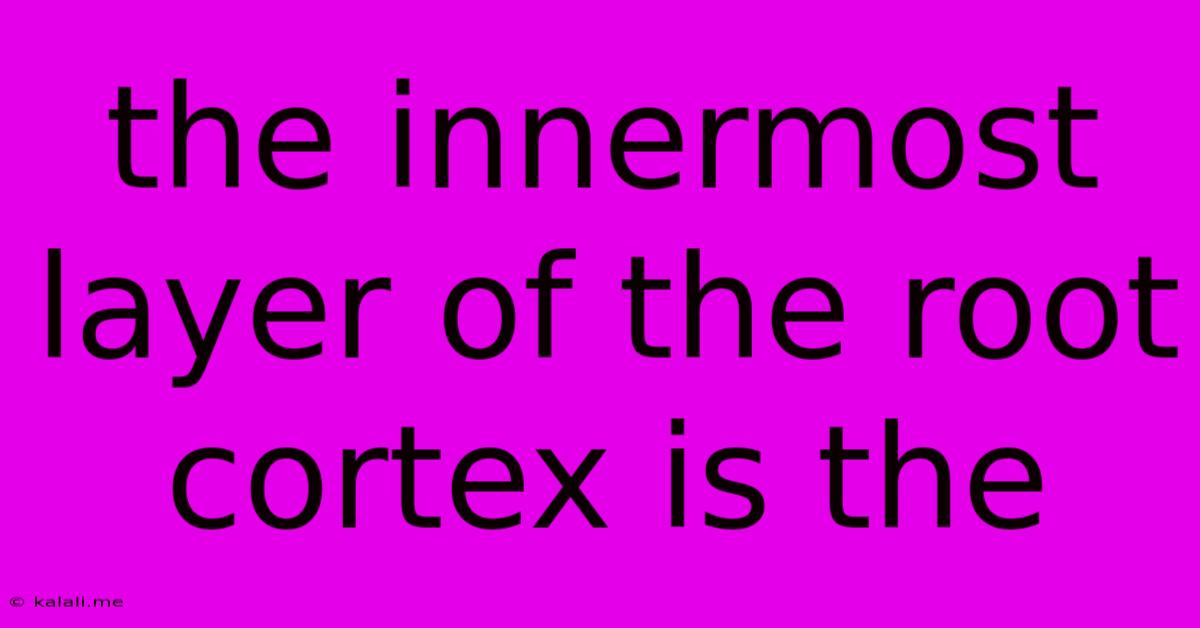The Innermost Layer Of The Root Cortex Is The
Kalali
Jun 15, 2025 · 3 min read

Table of Contents
The Innermost Layer of the Root Cortex: Understanding the Endodermis
The innermost layer of the root cortex is the endodermis. This single layer of cells plays a crucial role in regulating water and nutrient uptake by the plant, acting as a critical boundary between the cortex and the vascular cylinder. Understanding its structure and function is key to comprehending plant physiology. This article will delve into the intricacies of the endodermis, exploring its unique features and importance in plant survival.
The endodermis is characterized by the presence of Casparian strips, a defining feature that sets it apart from other cortical layers. These strips are bands of suberin, a waxy substance, deposited in the radial and transverse cell walls. This unique structure is vital for controlling the apoplastic pathway – the movement of water and solutes through the cell walls and intercellular spaces.
The Significance of the Casparian Strip
The Casparian strip's impermeability forces water and dissolved minerals to enter the symplast – the interconnected cytoplasm of the endodermal cells – via plasmodesmata. This controlled entry allows the plant to regulate the uptake of essential nutrients and prevent the absorption of harmful substances. This selectivity is a key adaptive mechanism that enhances plant survival in diverse environments.
The Endodermis and Apoplastic vs. Symplastic Pathways
The apoplastic pathway offers a less regulated route for water movement. However, the Casparian strip effectively blocks this pathway, ensuring that all water and nutrient uptake are subject to the plant's control. The symplastic pathway, on the other hand, involves the movement of water and solutes through the cytoplasm of cells, allowing for selective uptake regulated by membrane proteins and other cellular mechanisms. The endodermis, with its Casparian strip, effectively manages the transition between these two pathways.
Variations in Endodermal Structure
While the Casparian strip is a consistent feature, the development and structure of the endodermis can vary depending on the plant species and its growth stage. In some mature roots, the endodermal cells may develop secondary thickenings of suberin and lignin, further reinforcing the barrier properties of the Casparian strip. This suberization can be more pronounced in older root tissues.
The Endodermis and Water Uptake
The endodermis's role in water uptake is closely linked to its regulation of mineral transport. By controlling the influx of ions, the endodermis contributes to the generation of a water potential gradient that drives water movement into the xylem. This efficient uptake mechanism ensures that the plant maintains its hydration status, even under challenging environmental conditions.
Conclusion: A Vital Control Point
In summary, the innermost layer of the root cortex, the endodermis, is a pivotal tissue responsible for regulating water and nutrient uptake in plants. The Casparian strip, a defining feature of endodermal cells, plays a central role in controlling the apoplastic pathway and directing water and minerals into the symplast. Understanding the endodermis and its intricate mechanisms is crucial for comprehending plant physiology and its adaptations to diverse environments. The precise regulation facilitated by the endodermis is vital for the plant's health and overall survival.
Latest Posts
Latest Posts
-
Abstract Nouns That Start With K
Jun 16, 2025
-
Average Gpa For Azusa Pacific University
Jun 16, 2025
-
Which Type Of Em Wave Has The Longest Wavelength
Jun 16, 2025
-
Application Letter For Change Of Name
Jun 16, 2025
-
What Is The Chemical Formula Of Diamond
Jun 16, 2025
Related Post
Thank you for visiting our website which covers about The Innermost Layer Of The Root Cortex Is The . We hope the information provided has been useful to you. Feel free to contact us if you have any questions or need further assistance. See you next time and don't miss to bookmark.